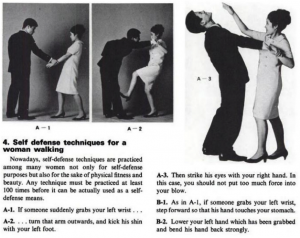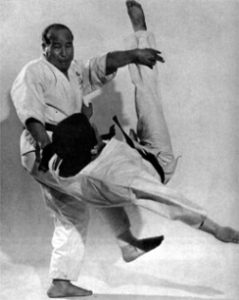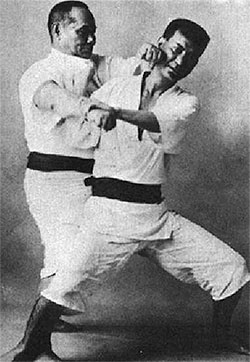Since beginning the podcast and opening conversations around training it has raised some questions for me in regards to my own training.
Shihan Judd Reid, the former Uchi Deshi of Sosai Mas Oyama, talked about his training under Sosai, Sensei Terry Birket talked about his training and his focus now on making karate (Kyokushin) dangerous again, through Goshin Jutsu, the guys from Karate Culture with their focus on bringing back the old ways, and most recently Shihan Cameron Quinn speaking about Sosai Mas Oyama’s Shin so seiki, “new genesis of Kyokushin“, all made me realize there is much more to karate, and in my case Kyokushin, then sport.
This post is meant to open a dialogue, raise questions and gather feedback.
What do you believe is the purpose of your training?
There is no question that Kyokushin is a Budo, with a focus on bettering oneself and character, cultivating an indomitable spirit, through hard training and overcoming personal obstacles. Which is a great purpose to have.
However, when I look at the origins of Kyokushin and the words / philosophies of the founder, Sosai Mas Oyama, there was also a focus on developing a martial art that was meant to be a force to be reckoned with, that could stand with any other martial form and be an ultimate form of self-defense, or Goshin-Jitsu (護身術).
Today however, there tends to be mostly a focus on the sport aspect of full-contact, or knock-down, fighting. Which of course is great! And Kyokushin is famous for it, but not everyone will compete, and for those who do, many won’t compete beyond an amateur level, and the others can only compete for so long before age catches up. So those who remain are left with the focus being the athletics and spirit, but should there be more?
Mas Oyama wrote dozens of books in Japanese (a few translated to English), and most had a focus on self-defense, utilizing the same components that make Kyokushin a formable force in sport full-contact knock-down tournament kumite. Utilizing kihon and applications of the kata in realistic training.
This isn’t meant to be a debate on the merits of kata (bunkai), but rather open the question of realistic self-defense training focus, in ADDITION to the sport tournament side.

Goshin-Jitsu
Kihon and kata by themselves won’t make you a good fighter and we know that. However they do have use. They develop focus, muscle and strength, muscle memory, proper breathing, and coordination, plus much more. And that’s if we put aside the bunkai aspect of kata, which can be very good…. IF and ONLY …. drilled properly.
Kyokushin isn’t just a sport, and I don’t believe it was meant to be. Knockdown fighting is the sport side of it but not the only focus. Originally there was a great focus on street techniques (developing reflexes, strikes to vulnerable parts of the body, joint locks, throws, etc.) But we don’t see much of that anymore.
There are many reasons for this I believe, but primarily it was the focus on competitive training in the 1970s, to help build and spread the reputation of Kyokushin.
Bunkai is rarely trained in Kyokushin, and other styles of karate. Realistic bunkai is even rarer. Training bunkai enough that you can use the techniques, as well as you can the kumite techniques, is almost unheard of.
Mas Oyama believed that if you wanted to use karate effectively for self-defense, you had to train hard and fight hard. In addition to traditional Kyokushin kihon (basics) and kata (forms), with their self-defense applications, Mas Oyama incorporated jissen kumite (full-contact fighting) into his style, but not exclusively.
The early days also incorporated grabs, throws, clinching, grappling, joint locks and much more. Remember, Sosai was also a 4th Dan in Judo, not to mention a teaching license in Aiki-jujutsu and Taikiken practice.
As a result, Kyokushin Karate evolved into one of the most formidable martial arts styles in Japan, and the world. It soon became known as “The Strongest Karate”, not only because of the incredible feats of strength and endurance that Mas Oyama performed, and not only because of the sport aspect, but also because of the rigorous requirements of training.
When you see pictures of Sosai in the early days, as well as his books, they incorporated strikes, joint locks and throws that come from kata and that are not used in kumite because of the rules.
One of his close students, Shihan Bobby Lowe was a big proponent of this type of training, developing video learning. Edward ‘Bobby’ Lowe (August 23, 1929 – September 14, 2011) was the first uchi-deshi (live-in student) of Masutatsu Oyama, and established the first Kyokushin school outside Japan.
Lowe held the title of “Shihan” and was the Senior Instructor and an International Committee Chairman of the International Karate Organization founded by Oyama.
Lowe wrote two books on Kyokushin Karate:
• Mas Oyama’s karate as practiced in Japan (1954)
• Kyokushin karate: Self-defense techniques (1999)
As well as a self-defense instructional video, Kyokushin Karate Self-Defense Techniques:
Goshin Jutsu Kyokushin with Shihan Bobby Lowe
Shihan Bobby Lowe's Goshin Jutsu Kyokushin Karate (Self-Defense Techniques)
Posted by The Martial Way on Wednesday, January 3, 2018
Recently I have noticed an increase in popularity for authentic scenario based training again and resurgence in traditional training methods. I believe this is in part because people are seeing moves in mma and thinking, hmmm… that looks familiar, I’ve seen that move before somewhere. Never noticing before that it was always a part of the kata, and had never trained it as such.
 Many of the moves you see in mma are not exclusive to one martial art. There are techniques you see in BJJ, Sambo, Muay Thai, etc., that can be found in the traditional syllabus of Okinawan Karate. The human body can only move and react in so many ways.
Many of the moves you see in mma are not exclusive to one martial art. There are techniques you see in BJJ, Sambo, Muay Thai, etc., that can be found in the traditional syllabus of Okinawan Karate. The human body can only move and react in so many ways.
You don’t have to train for this purpose. Kihon and kata are very good strength and conditioning exercises. For example doing a kata in horse stance develops very powerful and strong legs and doing the basic blocks and punches as drills develop strength, as the same muscle groups are used as in sparring. However, there is so much more, if you are willing to put the time, effort and training in, as well as forgoing ego.
My own personal background included many years training in a purely self-defense system. Kenpo. An offshoot of the system Shihan Bobby Lowe was doing before his switch to Kyokushin. However, it lacked realism and contact, so I sought out Kyokushin and an incredible teacher to fill that gap.
Now having trained for a few years in Kyokushin I see that it can be an ultimate form of martial art, because it does have those components as well. We just don’t focus on them often.
How I was taught (which I know was the way it was taught in Okinawa, and still is by traditionalist) was first the self-defense application, practiced on opponents until it is completely natural to you. Then the next technique, and so forth. Then, and only then, the kata would be taught, just so you could use it as memory tool for solo training. Yes, it was important somewhat to have the kata look nice aesthetically, but not much emphasis was on the kata, it was on the application.
The gentlemen of Karate Culture are doing an outstanding job at educating people on this component of their karate (no mater what their style), showing people what a complete system they might already have at their disposal, if they are willing to put aside personal ego and biases to investigate.
Another person who has gained great notoriety for Karate Jutsu is Sensei Vinicio Antony, of ABKJ (Brazilian Association of Karate Jutsu). He is an instructor to MMA legend Vitor Belfort, with a strong focus on traditional karate application in self-defense and applied mma fighting, with a long record to prove his philosophy. A philosophy that shows Karate can be used in the octagon or street with great success, or else, what is the point.
“They normally train jiu-jitsu, wrestling and Muay Thai. Usually, most MMA fighters think karate is funny, like Jake Ellenberger said to Stephen Thompson before getting knocked out.” – Sensei Vinicio Antony
And lately you are seeing a growing movement within Kyokushin doing the same. Sensei Terry Birkett of Ronin Dojo in the UK has a huge focus on Goshin-Jitsu, with a Facebook page dedicated to this.
Kyokushin as a system has more kata than many, combing many from the Shuri systems (Shotokan) as well as Naha systems (Goju-ryu). Why would Sosai Oyama have included all of these kata? Was it just to hang onto the roots, cultural significance? Or is it possible he believed in them and wanted it to be a focus of his karate?
Most recently in my conversation with Shihan Cameron Quinn, he alluded to Sosai Oyama working on the new direction of Kyokushin before his passing. Shin so seiki, the “New Genesis” of Kyokushin. They had focused on and conquered the full-contact sport side, but what about the people who don’t fight tournaments, or those who are aging past tournament kumite, or those looking for something more in their training. Shihan Quinn believed that Sosai wanted to take Kyokushin full-circle back to the bases of their training, focusing on self-protection in a hard realistic style, which Kyokushin is known for.
Here is an excerpt of that conversation where he discusses this:
Shihan Cameron Quinn on the future of Kyokushin
Shihan Cameron Quinn on Sosai Oyama's vision of the future of Kyokushin. Shin so seiki, the "New Genesis" of Kyokushin. Excerpt from my conversation with him this past week. See the full video or podcast here: http://the-martial-way.com/episode-5-shihan-cameron-quinn/
Posted by The Martial Way on Wednesday, January 3, 2018
Self-Defense (Goshin-Jitsu) , or as Shihan Quinn says, “self-protection”, techniques and applications can increase your options and help you prepare responses to slow down, de-escalate, or interrupt an attack.
Kyokushin Karate Goshin-Jitsu training offers you concepts and skills found in your kata and kihon designed to develop self-protection strategies including blocks, strikes, and take-downs that will help you to defend yourself in a real conflict situation. But ONLY if you train for such scenarios.
There are a lot of opinions of whether Kata and traditional martial arts are worth practicing, mostly because of MMA, Muay Thai, BJJ and other combat sports having such popularity. Why train traditionally when you can take mma and have a full system?
I realize there are many people, including those in Kyokushin, who think Kata training is a complete waste of time and training should be spent on more functional drills and sparring, and that if you train kata it’s only because it is part of their heritage and a “must”, without a clear understanding of the meaning of the movements. So, why even have the kata? Some groups have removed them, focusing exclusively on the sport fighting aspect.
What many fail to realize is that kata can be considered entire protection art all to its own. In the old days of karate training in Okinawa the masters of old studied one kata for a minimum of 3 years to become proficient. Not only in the movements, but the applications within.
However, it is VERY important that people know there is a strong difference between self-defense training and that of kumite, or sparring.
Choki Motobu, a prominent Okinawan Karate, and very famous for his abilities, was born in Shuri, the old capital of Okinawa, in 1871. He had considerable local fame in Okinawa as a fighter-strongman but it was only after he moved to Osaka in 1921 that he became known in Japanese martial art circles.
What brought Motobu to the attention of the Japanese was his victory over a western boxer in a kind of all-comers challenge match. Think UFC. In the earlier part of this century such bouts were occasionally held in Japan pitting western boxers against judo or jujutsu men, (karate was unknown in Japan around this time). These were not “official” bouts for any sort of legitimate title, but something more like sideshow attractions.
Motobu was well known for his fighting abilities and legendary street brawls, which didn’t always favour well with those in traditional martial arts circles. Never the less, he was incredibly respected.
Choki Motobu, had this to say about kata and self-defense:
The applications of kata have their limits and one must come to understand this.
The techniques of kata were never developed to be used against a professional fighter, in an arena or on the battlefield.
They were, however, most effective against someone who had no idea of the strategy being used to counter their aggressive behavior. – Choki Motobu
In other words, Karate was not designed for fighting a in a ring or cage. It was specifically designed to be a civilian method of self-preservation (close quarter combat) against someone not prepared for retaliation by a skilled Karate practitioner.
Another quote by Choki Motobu:
Nothing is more harmful to the world than a martial art that is not effective in actual self-defense. – Choki Motobu
 Another interesting note to consider is that karate is known as a “striking” martial art. However, the opposite is in fact true. Karate was, and still is, made up mostly of grappling / joint manipulation, rather then strikes. Most of the “space” between the strikes are grappling and throws.
Another interesting note to consider is that karate is known as a “striking” martial art. However, the opposite is in fact true. Karate was, and still is, made up mostly of grappling / joint manipulation, rather then strikes. Most of the “space” between the strikes are grappling and throws.
If you look into the bunkai, or“analysis” and “disassembly” of kata, you will learn that the obvious movements in a kata are typically not the intended action, and it requires you to deconstruct each of the movements to fully understand it.
For example, what you might think of as a simple block is intended to be grabbing, manipulation and striking.
But because of the focus on sparing, striking and kicking, much of this has been lost in most dojos.
It is important not to look at the kata in it’s full sequence. They were arranged like this only to be used a mental memory tool to log all of the various movements. Each and every move is a technique all to its own that can be used in conjunction with any other movement. Hence, it isn’t shadow boxing, but merely an encyclopedia to be used as reference.
 Karate has become less popular over the years. The rise in popularity of Brazilian jiu-jitsu, MMA, Olympic Tae Kwon Do are part of the reason.
Karate has become less popular over the years. The rise in popularity of Brazilian jiu-jitsu, MMA, Olympic Tae Kwon Do are part of the reason.
MMA has become the “complete” martial art. However, Karate has always been a ‘mixed martial art’. It just isn’t practiced much that way any more. It became watered down to kicks and punches to be used in sport.
The modern karate movement is taking karate back, back to old school!
It is the modern karate movement. A focus on the techniques from kata and practicing a complete system for practical self-defense.
Karate is much more than kicks and punches. Throws, trips, locks, sweeps, takedowns, strangles, chokes, grappling… it’s all there. The old masters knew this:
“In karate, hitting, thrusting, and kicking are not the only methods, throwing techniques and pressure against joints are included … all these techniques should be studied referring to basic kata” – Gichin Funakoshi, Founder of Shotokan Karate-Do, 1935
The fact that those who have learnt karate there (referring to karate introduced to Tokyo) feel it only consists of kicks & punches, and that throws & locks are only to be found in judo or jujutsu, can only be put down to a lack of understanding … Those who are thinking of the future of karate should have an open mind and strive to study the complete art” – Kenwa Mabuni, Founder of Shito-Ryu Karate-Do, 1938
I truly believe Karate is making a comeback. But if karate is going to be relevant in the modern era it has to keep up with the times, even if that means having to step back in time a little. To a time when karate was dangerous.
I personally believe to do this the first thing that has to happen is the removal of the ego. Just return to hard training focused on civilian self-defense, as well as the sport side.
“The true science of martial arts means practicing them in such a way that they will be useful at any time, and to teach them in such a way that they will be useful in all things.” ― Miyamoto Musashi, The Book of Five Rings
I am certain there are many opinions about this, and I am certainly not saying my views or ideas are correct, or the only way. There are just my thoughts…. and I welcome yours!
Osu!








